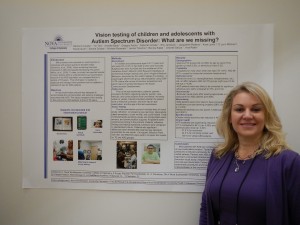NSU Newsroom
SharkBytes
Horizons
This version of NSU News has been archived as of February 28, 2019. To search through archived articles, visit nova.edu/search. To access the new version of NSU News, visit news.nova.edu.
This version of SharkBytes has been archived as of February 28, 2019. To search through archived articles, visit nova.edu/search. To access the new version of SharkBytes, visit sharkbytes.nova.edu.
Optometry Faculty Present Research on Autism Research
Rachel A. “Stacey” Coulter, O.D., M.S., and Annette Bade, O.D., Nova Southeastern University College of Optometry faculty researchers presented research results at the International Meeting for Autism Research (IMFAR) in San Sebastián, Spain on May 4. Their presentation, Vision testing of children and adolescents with Autism Spectrum Disorder (ASD): What are we missing?, summarized outcomes of a 2-year study comparing eye examination testing in children and adolescents with ASD to those of typically developing controls. Using an eye examination protocol designed to accommodate the communication and sensory challenges associated with ASD, the faculty investigators studied the effectiveness of the examination protocol and compared vision findings between patients with and without ASD. Approximately, 61 patients, including 34 with ASD, participated in the study. Coulter and Bade also attended sessions showcasing research from all over the world addressing aspects of ASD. They also attended the Stakeholder Networking luncheon to learn about current research in epidemiology and public health and to meet attendees who were individuals with ASD or their family members living with ASD.
Coulter summarized their experience stating: “Although basic science research in genetics and neurophysiology may ultimately identify the cause of Autism Spectrum Disorders, stakeholders want information now. The key areas of interest are intervention, access to health care, and services for individuals with ASD across the lifespan.” Our work in vision targets these needs, Coulter said. “We found that children and adolescents with ASD, regardless of their level of verbal communication can complete most tests in a comprehensive eye examination using our protocol. This matters because our data suggest that patients with ASD may be less likely to receive vision examinations and to be corrected for significant amounts of nearsightedness and farsightedness,” she said.
At NSU, this research has been applied to clinical practice, Coulter said. “Within the NSU optometry and occupational therapy services, we are using our research results to improve vision care and sensory processing interventions for patients with ASD,” she said. Research results have also been used to train practitioners throughout the United States on how to provide care to their patients with ASD. Coulter and Bade and their colleagues plan to continue their work through future studies to investigate vision function and intervention in patients with ASD.

